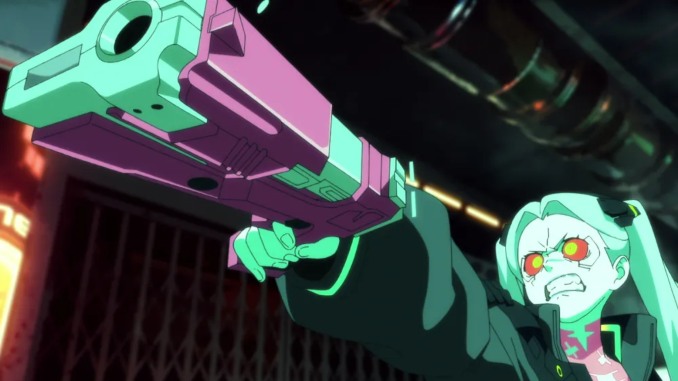Cyberpunk: Edgerunners Delivers Ultraviolence with a (Cybernetic) Heart
Photo Courtesy of Netflix
Cyberpunk 2077 launched to widespread disapproval, drawing criticism for feeling unfinished and falling short of its massive ambitions. But despite its infamy, the game has recently catapulted back into the spotlight thanks to a Netflix anime from Studio Trigger and CD Projekt, Cyberpunk: Edgerunners.
Edgerunners is an unabashedly juvenile splatterfest, a culmination of Trigger’s ability to produce iconic imagery that elevates familiar genre beats through raw, hyperbolic cuts of animation. It’s brash, loud, and as subtle as the explosions of gunfire, gore, and garish colors that fill its frames. Perhaps most importantly, the chaotic violence is used to deliver heart-wrenching turns as the show plays with the fates of its strangely likable cast. While this crime caper may not break from the core issues of this franchise or cyberpunk more broadly, it manages to hit more than a few emotional highs and look very good in the process.
The story follows disaffected high schooler David Martinez who, after experiencing personal tragedy, meets a mysterious hacker named Lucy and falls in with her crew in the dystopian sprawl of Night City, where the videogame and table-top RPG take place. From here, David slips deeper into a world of constant brutality, corporate warfare, and deceit as this doomed metropolis threatens to swallow him whole.
Though cyberpunk has been done to death, Edgerunners’ excessive visuals set this depiction of it apart. Studio Trigger and director Hiroyuki Imaishi (Kill la Kill, Gurren Lagann, Promare) have become known for a house style that uses exaggerated proportions, bold color combinations, and non-traditional animation techniques to create an escalating sense of spectacle. Despite its hypothetically “grounded” setting, their latest work fits perfectly into this trend of artistic extremes. Edgerunners’ literal first scene is a grindhouse shootout where a berserk cyborg blasts through hordes of cops, red and blue police lights adorning viscera as bullets turn bodies into fine red paste. Intentionally choppy sequences heighten the carnage as time is slowed and sped up to accentuate each grisly impact.
Though this degree of bloodshed would normally be numbing, the in-your-face aesthetic is eventually used to externalize the big emotions of its characters in suitably grandiose manner. After all, Imaishi directed Gurren Lagann, a series that concludes with galaxy-sized robots throwing literal constellations at each other. He doesn’t do subtle. Though things don’t get quite that cosmic here, a similar sense of maximalism permeates the setting and emotional conflicts of its cast.
-

-

-

-

-

-

-

-

-

-

-

-

-

-

-

-

-

-

-

-

-

-

-

-

-

-

-

-

-

-

-

-

-

-

-

-

-

-

-

-








































